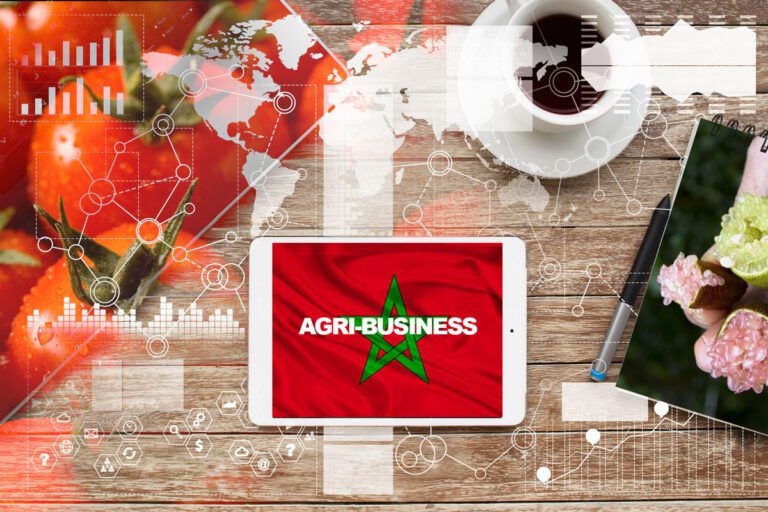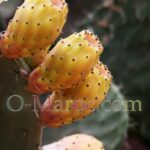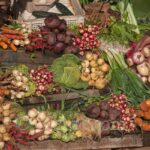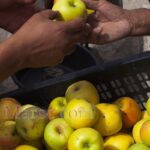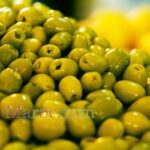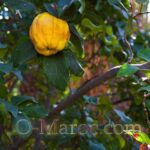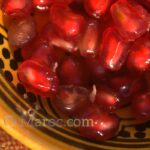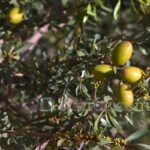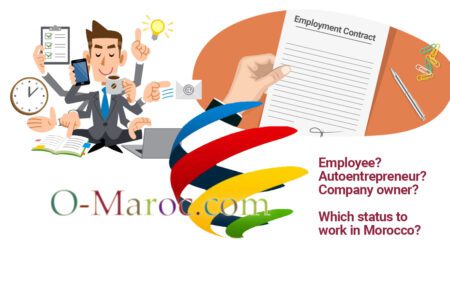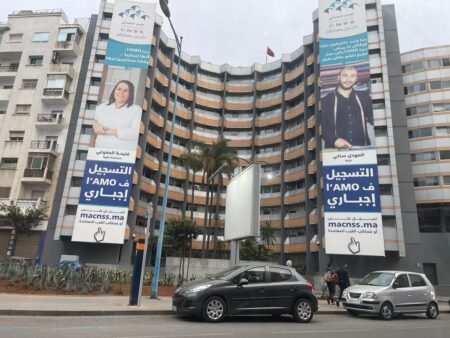Morocco is still an essentially rural country. It is also a very arid country, which has suffered from severe water stress for many years. Finally, it is a country with some very fertile areas, in particular the Doukkala and Chaouïa plains, around Casablanca, and the entire Sous region. Apples, walnuts and almonds are grown in mountainous areas. Finally, in some regions, there are very localised crops that are exported, such as saffron and roses.
Agriculture and the agri-food industry: a strategic sector for Morocco
Agriculture alone accounts for 14% of GDP and employs 4 million people. If we add the agri-food industry, we arrive at 20% of GDP.
In terms of exports, in 2019 the sector brought in foreign currency worth 50 billion dirhams, 85% more than in 2010. Overall, the sector accounts for 20% of Morocco’s exports and just under 10% of its imports. In 2019, the food balance was slightly in surplus, with exports accounting for 116% of imports.
Morocco is seeking both to achieve self-sufficiency (already achieved in a number of sectors) and to develop major export activities that generate foreign currency. It is also a sector where many farms are small, techniques are not always modern, and products are not always of very good quality (at least on the domestic market).
Finally, it’s a sector where processed products are rare. In short, Morocco sells tomatoes and chickens instead of tomato sauces and nuggets. (Personally, I’m against the nugget industry, but that’s another debate).
Morocco is at the same stage as France was in the 1950s. France succeeded in developing a first-rate agri-food industry. This is the path that Morocco is seeking to follow, adapting it to its own context. However, FDI (Foreign Direct Investment, the kind you make when you move to Morocco) is much higher in tourism than in this sector. This is probably because it’s more difficult to invest in a farm than to buy a riad. But agri-food is not just about production, processing is just as important.
A priority and strategic sector, it is one that is strongly supported by the Moroccan government at every stage, both financially and technically. It is also a highly controlled sector, with particular constraints for foreigners, who are not allowed to buy agricultural land. They can, however, benefit from land belonging to the State (the “Domaines”) which is granted on a long-term basis to be developed and farmed by the beneficiary.
Reducing food dependency
Food dependency has been achieved in some sectors (meat and milk), but is worsening for other products, both because of rising world prices and because of increasing demand. This is particularly the case for wheat, sugar and oils.
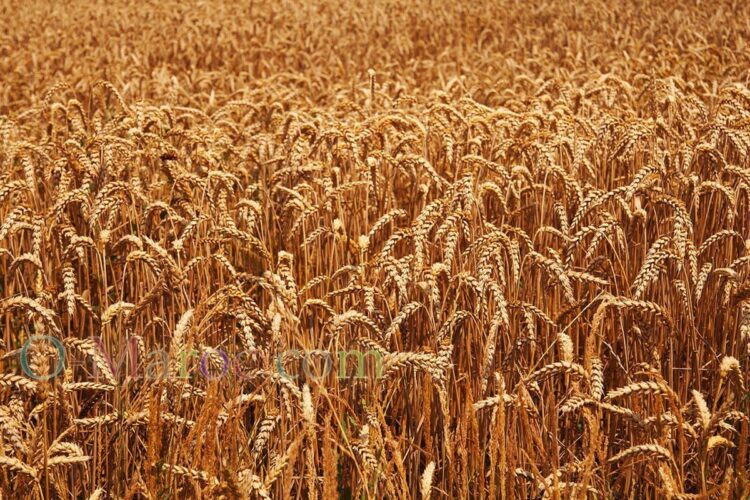
The situation with wheat is worrying. It is the basis of bread and couscous, two essential foods for Moroccans. Cereals account for around 75% of cultivated land, but of the 9.5 million hectares of cultivated land, only around 1.4 million hectares are irrigated. A large proportion of Moroccan wheat is soft wheat, developed during the Protectorate and much less suited to the local arid climate than durum wheat, which was traditional until the arrival of the French.
Morocco’s strategic products
When you think of “agriculture” in Morocco, you immediately think of oranges, argan oil, olive oil… in reality, Moroccan products are much more diverse.
One of the obsessions of the Protectorate was the development of Moroccan agriculture. In addition to wheat, citrus fruit and market garden produce, it also virtually “created” products such as roses from Kelaa M'Gouna (for the perfume industry in Grasse), caper plants or organised the cultivation of products that were already well known but for which local production was low, such as tomatoes.
Finally, local products such as safran of Taliouine have been able to develop internationally as markets have changed, with the biggest traditional suppliers, Iran and Kashmir, having problems with production or even access to exports.
Here are a few examples of opportunities, both for export and on the local market:
Tomatoes and tomato sauce
The cost of transporting Moroccan tomatoes is higher than the price of the product. The tomato has been selected in the Green Morocco Plan, along with oils and apricots, for priority development of processed products.
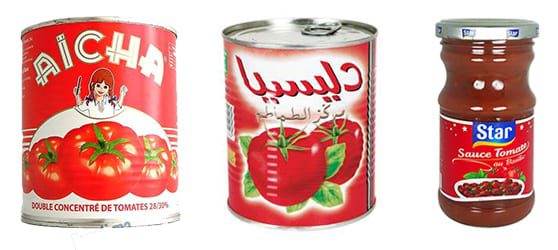
Three Moroccan tomato sauce brands, Delicia (Bicha group, which also makes Joly preserves), Aïcha (Conserveries de Meknès) and Star (Vinaigrerie Moutarderie du Maroc, which also makes Pescada and El Baraka) offer simple products: tomato sauce, concentrate and pizza sauce. Everything else (pesto, etc) is imported. Only Star offers sauces flavoured with meat, basil, etc., and these are recent (and not very good).
What can be done:
- identical” products, but organic,
- development of ancient varieties, such as a genuine beef heart,
- sauces made with vegetables, meat and typical Moroccan products (believe me, I’ve tried a homemade tomato sauce with red onions and argan oil, it’s delicious),
- selling Moroccan tomatoes on new markets (the difficulties between Europe and Russia have been a real opportunity for Morocco, which is now looking to break into the Ukrainian and Polish markets).
Citrus, fruit and market garden produce
Morocco is both an importer and exporter. On local stalls, depending on the season, the same product may be local or imported.
Morocco is growing more and more local varieties to replace imported products, on the one hand, and to position itself for export, on the other. For several years now, different varieties of squash, for example, have appeared alongside the classic pumpkin: turban squash, butternut, jack-o-lantern, even.
For someone like me, with a passion for cooking, this is often a source of frustration, as these new local products don’t always live up to my expectations. The large balls of imported celeriac have been replaced by local celeriac, albeit very small (a Moroccan ball is the size of a fist).
What can be done:
- developing organic products
- develop new products of the required quality, such as caviar lemons in Essaouira.
- making processed products (top-of-the-range organic jams, quince paste, etc.)
- provide advice, if you have agronomic know-how
- open a shop selling quality products in a large town
Regional products
The Green Morocco Plan has defined 35 PGIs and PDOs and two agricultural labels. Argan oil, olive oil, Berkane clementine, Taliouine saffron, dates, pomegranate, prickly pear, Beni M’guil sheep, lavender… All these products are supported by the Moroccan government, which already helps producers a great deal to produce quality products. They are therefore a reliable source of products for processed products. Morocco also promotes them at international fairs and shows, so you benefit from export assistance.
I’ll leave you to browse the list of Moroccan PDOs and PGIs here.
Having introduced you to the wide variety of Moroccan products, now comes the basic question:
How to invest in the agri-food sector in Morocco
Setting up a company in this field is not as simple as opening a riad or setting up on your own to create websites.
First of all, there is the nationality constraint: you have to be Moroccan to own agricultural land, either directly or indirectly via a company (when the company is the owner, the majority of its shareholders must be Moroccan).
Secondly, there are health standards in Morocco. While the ONSSA continues to turn a blind eye to micro-farms, or rather does not check them as a matter of priority, for newly-created businesses – particularly those run by foreigners – inspections and checks are real and serious. So you need to be a professional in the field, or be accompanied by one, because you can’t become a farmer or canning specialist overnight.
On the other hand, if you have the necessary qualifications, this is a very well-supported sector. You can benefit from substantial financial aid, both from the Moroccan government and from international organisations, as well as technical aid and export support.
I’ve already given you some examples above, but here are the types of activity that seem to me to be the most interesting:
- Improve local production
- Add value to the product
- Conquer new export markets
- Create niche products for the domestic (or even export) market
Finally, a fifth type of activity can be very profitable: “shovel salesman”, in other words manufacturer, importer, distributor of products for agriculture, and in particular everything to do with irrigation techniques, renewable energies and the development of organic farming. But that’s a post in itself!
 A typo or syntax error? You can select the text and hit Ctrl+Enter to send us a message. Thank you! If this post interested you, maybe you can also leave a comment. We'd love to exchange with you !
A typo or syntax error? You can select the text and hit Ctrl+Enter to send us a message. Thank you! If this post interested you, maybe you can also leave a comment. We'd love to exchange with you !

